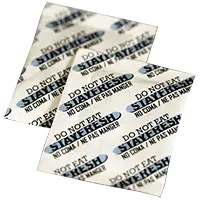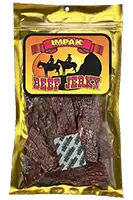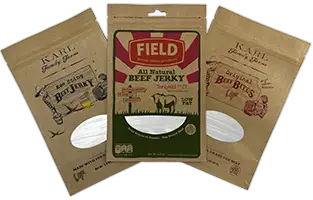
All About Oxygen Absorbers

What Are Oxygen Absorbers?
Oxygen absorbers are added to air-tight packaging to help remove or decrease the available oxygen in the package. They are used to help maintain product safety and extend shelf life. There are many types of oxygen absorbers available to cover a wide array of applications. The components of an oxygen absorber can vary greatly depending on what it is being used for, the water activity of the product being preserved, and many other factors. Often the oxygen absorber or scavenger is enclosed in a porous sachet or packet, but it can also be part of packaging films and structures. For most products, a mixture of iron powder, sodium, and activated carbon (charcoal) has proven quite effective. Iron powder is the primary component, while sodium acts as an activator, causing the iron particles to rust, effectively reducing the oxygen level in the surrounding atmosphere to approximately 0.01% when used appropriately. Activated carbon acts as a gas absorbent, further preserving products and removing unsavory odors.
How Oxygen Absorbers Work:
When an oxygen absorber is removed from its protective packaging, the moisture in the surrounding atmosphere begins to mingle with the iron particles inside of the oxygen absorber sachet. As the oxygen molecules from the moisture interact with the iron (Fe) particles, rust begins to develop. Typically, there must be at least 65% relative humidity in the surrounding atmosphere before the rusting process can begin. To remedy this dilemma, sodium is added to the mixture. The sodium acts as a catalyst, or activator, causing the iron powder to rust even with low relative humidity. With the conversion of iron and oxygen into a single iron oxide substance, the presence of oxygen in the surrounding atmosphere is dramatically reduced.
The performance of oxygen absorbers is affected by the ambient temperature and relative humidity. Activated Carbon (C), also called activated charcoal or activated coal, is a highly porous substance that allows gases to pass through and interact with the exposed carbon. As the gases interact with the carbon, most impurities and contaminants are adsorbed and neutralized. As a result, the presence of undesirable odors is greatly reduced. For packaging that requires a very low % of oxygen, these live up to the name "scavengers" by thoroughly removing the oxygen from its environment.
Why Do I Need Oxygen Absorbers?
When packaged properly (i.e., an appropriately sized oxygen absorber inside of a high oxygen barrier can or bag), the oxygen level in the surrounding atmosphere is effectively reduced to approximately 0.01%. Therefore, oxygen absorbers extend the shelf life of your food, prevent oxidation, and are even used to protect from insect damage.
More than any other atmospheric element, oxygen supports the growth of aerobic microorganisms such as fungi and mold. With the growth of these microorganisms, the integrity of a package is drastically compromised. In food products, discoloration takes place, rancidity and putrefaction set in, and the possibility of food poisoning is ever present. With historical documents, art and other artifacts, the presence of oxygen contributes to rapid deterioration, mildew, mold and a wide array of other contaminants. Oxygen absorbers were designed to protect against such problems.
What Amount of Oxygen Absorber Should I Use?
CC stands for cubic centimeter (cm3). It's a unit of measurement that is equal to milliliters (ml). For example, 10 cc = 10 ml. So, 200 cc oxygen absorbers will absorb 200 cm3 of oxygen.
| Bag Size | Packaging Fine Grains (sugar, flour, etc.) |
Packaging Less Dense Foods (pasta, dried fruit, etc.) |
|---|---|---|
| 6" x 6" | 20 CC | 50 CC |
| 8" x 8" | 50 CC | 100 CC |
| 10" x 14" | 100 CC | 200 CC |
| 10" x 16" | 150 CC | 300 CC |
| 16" x 18" | 500 CC | 1000 CC |
| 18" x 28" | 750 CC | 1500 CC |
| 20" x 24" | 750 CC | 1500 CC |
| 20" x 30" | 1000 CC | 2000 CC |

IMPAK supplies millions of oxygen absorbers to the beef jerky industry. Whether you sell beef jerky, salmon jerky, vegan jerky, or any other food product intended for long term storage, please consult with one of our expert sales specialists for your packaging solutions.

Benefits of Oxygen Absorbers:
- Helps retain fresh-roasted flavor of coffee and nuts
- Prevents oxidation of spice oleoresins present in spices themselves and in seasoned foods
- Prevents oxidation of vitamins A, C and E
- Extends life of pharmaceuticals
- Inhibits mold in natural cheeses and other fermented dairy products
- Delays non-enzymatic browning of fruits and some vegetables
- Inhibits oxidation and condensation of red pigment of most berries and sauces
- Oxygen deprivation contributes to a pest-free environment in museums
Typical Applications:
- Breads, cookies, cakes, pastries
- Nuts and snacks
- Candies and confectioneries
- Coffee and tea
- Whole fat dry foods
- Processed, smoked, and cured meats, cheeses, and dairy products
- Dried fruits and vegetable
- Spices and seasonings
- Flour and grain items
- Fresh and precooked pasta and noodles
Reasons to Get Oxygen Absorbers from IMPAK:
- Quality: Every single production run is put through a series of tests to ensure the oxygen absorbers can successfully perform their job. Stock is routinely rotated to ensure that our oxygen absorbers are sold in a timely manner.
- Price: The ability to produce high volume production runs allows us to be flexible in our pricing. Substantially discounted pricing is available for larger orders.
- Availability & Selection: IMPAK maintains a regularly stocked supply of all sized oxygen absorbers. Whether you need a single pack of 100cc oxygen absorbers, or 50 full cases of 2000cc oxygen absorbers, we have them on hand.
- Technical Support: Realizing how important your product storage and preservation is, IMPAK has in-house technical staff to assist you.
